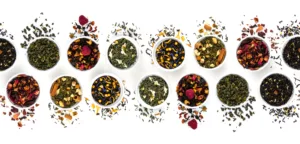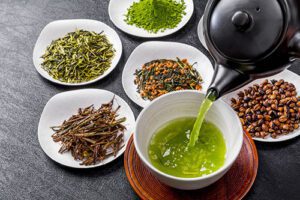Have you noticed how some teas are more expensive than others? There are several reasons that can contribute to the high cost of certain types of tea, so grab a brew and some of your favorite cookies and dive into some of the most expensive teas in the world with us.
Here are some of the reasons why your cup may be expensive:
Rarity: Some types of tea are rare and can only be grown in certain regions or climates or only during certain times of the year. The limited supply of these teas can raise their prices quite a bit!
Quality: The highest quality teas are often picked by hand and processed using traditional methods, which can be time-consuming and require a high level of skill. This can increase production costs and lead to a higher price for tea.
Processing: Some types of tea, such as Matcha tea or Dragon Tears, require complex and time-consuming processing methods. This may include shading the tea plants, steaming, hand-rolling, or mixing the tea leaves with other expensive ingredients. These additional processing steps can easily add to the overall price of the tea!
Origin: The region where the tea is grown can also affect its price. For example, teas grown in high-altitude areas may be more expensive due to the difficult growing conditions and limited supply of tea produced in these areas.
Packaging and presentation: How the tea is packaged and presented can also affect its price. High-quality teas may be packaged in decorative or unique containers, or sold in limited-edition packages, which can really drive up the price.

Here are the Top 10 most expensive teas in the world:
Da Hong Pao
This Oolong tea is grown in the Wuyi Mountains, an area in China with unique rocky and mineral-rich soil, which gives the tea a nutty, floral and fruity flavor with a sweet and smooth aftertaste. Da Hong Pao tea is hand-harvested and processed using traditional methods, which include withering, rolling and roasting the leaves to create the complex and rich flavor. This tea is often served during special occasions or given as a gift to show respect and appreciation. In 2018, a single kilogram of Da Hong Pao sold for $1.2 million!
HERE you will find the organic Da Hong Pao we have in our collection!
Tie Guan Yin
A high-quality Oolong tea cultivated in the rocky and foggy soils of Xiping, Gande and Muzha, which are located in Fujian Province, China. This tea has a floral and creamy taste with notes of orchid and honey. Tie Guan Yin tea is a partially oxidized oolong tea, meaning it is in between green and black tea in terms of oxidation level. The leaves are hand-picked and then processed by withering, shaking, oxidizing, fixing, rolling and roasting to achieve its distinct flavor profile. This tea is often made using a traditional Chinese tea-making method called “Gongfu Cha”, which involves using a small teapot and multiple short infusions. An interesting fact about Tie Guan Yin tea is that it can be infused multiple times, with each infusion bringing out different flavors and nuances from the leaves, making this a tea that can be enjoyed with multiple infusions. A kilogram of Tie Guan Yin can range from $300 to $1,500.
Pu-Erh tea
This unique tea is made in Yunnan, China. The fermentation process involves microbial activity that transforms the tea leaves, giving Pu-Erh tea its characteristic earthy and sometimes woody flavors. Pu-erh tea is often pressed into (tea) cakes or bricks and left to age for several years or even decades, which can result in a deeper, richer flavor profile with increasing complexity.
HERE you will see our collection of Pu Erh from China and S. Korea!
Gyokuro
This tea plant is kept in shade cloth to limit exposure to sunlight, which slows leaf growth and encourages the development of desirable characteristics such as rich umami flavor, strong aroma, and high levels of chlorophyll. The shading process requires careful monitoring and precise control of temperature, humidity and light levels. Only the tender, young leaves are harvested by hand, as they contain the highest concentration of flavor. The leaves are then carefully processed using methods such as steaming, rolling and drying to preserve their delicate flavor and aroma. The shading process and picking of the leaves by hand make the production of Gyokuro tea quite intensive labor and time wise, resulting in limited supply and a high price. A kilo of Gyokuro can cost around $200, not as expensive as some of the others mentioned, but it makes it stand out among all these unique teas.
HERE discover our Gyokuros!
Yellow Gold Tea Buds
This golden drink is grown in the Sichuan province of China. This is a rare tea, made from tea buds covered in tiny golden hairs. The buds are then withered, pan-fried to stop oxidation, and wrapped in special yellow cloth for a slow oxidation and fermentation process. Yellow tea is a rare and less commonly produced type of tea compared to green, black and oolong teas, and as you’d expect, this tea is sweet, floral and smooth, with a soft and lingering aftertaste. In 2017, a kilo of Yellow Gold Tea Buds sold for $3,000.
Silver Tips Imperial Tea
Silver Tips Imperial Tea is a type of white tea covered in many small white silver hairs, and is often considered a superior grade of Silver Tips tea. It is made from the young, tender buds of the tea plant, usually harvested in early spring when the buds are at their peak quality! The buds are carefully plucked by hand and processed with great attention to detail, resulting in a tea of the highest quality, which produces a delicate, floral tea. A kilo of Silver Tips Imperial Tea can cost around $1000.
HERE you will find the Silver Tip from Sri Lanka!
Vintage Narcissus
A high quality oolong tea that has been matured for over 100 years, which helps to produce a tea with enhanced rich flavor – this has notes of caramel, honey and orchid. Traditionally this tea is collected by specialist tea pickers who pick only the best high quality leaves by hand. After harvesting, the tea is processed and allowed to mature according to the desired taste. In 2018, a kilo of Vintage Narcissus sold for $6,500.
Jun Shan Yin Zhen
An extremely valuable, rare yellow tea grown on the beautiful and scenic Jun Shan Island in China. A tea that is considered a luxury and collectable by tea lovers around the world. It is known for its sweet, nutty taste reminiscent of chestnut and is produced using only the buds of the plant! A kilogram of Jun Shan Yin Zhen can cost around $3,000.
Longjing (Dragon Well)
A high-quality green tea grown in the West Lake area of Hangzhou. The name “Dragon Well” comes from the legend of a dragon that lived in a well near a temple in Hangzhou, the dragon was said to control the rain and bring prosperity to the area! It has a nice balance of sweet and savory flavors, probably due to its traditional processing methods, i.e. hand picking and deep frying! In 2021, a kilogram of Longjing tea was sold for about $6,000!
HERE see our Long Jing!
Jasmine Pearls
This high quality white tea is gently rolled into small pearls and left to infuse with jasmine flowers – but not just any old flowers, fresh jasmine flowers that have been picked at just the right time (early in the morning when the flower is still closed) to ensure the better quality. Making these beautiful little pearls is time consuming and requires great skill, but it is important to use the right processing methods to create this delicious tea.
HERE discover the unique Jasmine Dragon Pearls from Sri Lanka!
But what about Matcha?
Matcha is green tea stronger than all greens and with a special taste. Cultivated in shady areas, after the leaves are collected by hand, they are dried and ground very slowly from granite into a very fine powder using traditional stone mills. The finely powdered leaves are then immediately packed and sealed, locking in all the good stuff—antioxidants and nutrients that is. Matcha’s growing popularity may also contribute to its price. As more and more people become interested in matcha and its health benefits, the demand for high-quality matcha increases, which can drive the price up even more.
HERE see Matcha and its utensils!



